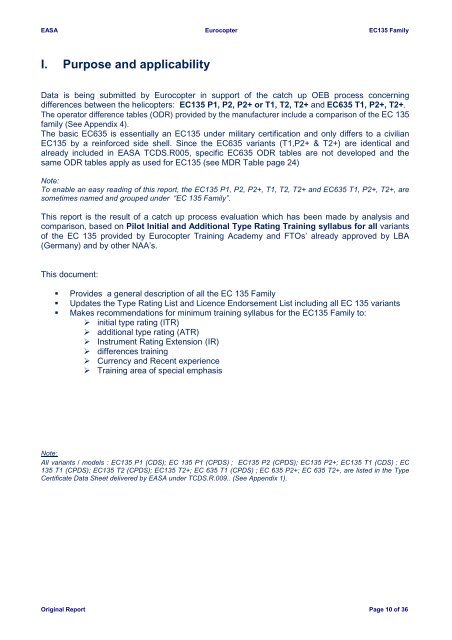Final report EC 135 Family-23 07 12 - EASA
Final report EC 135 Family-23 07 12 - EASA
Final report EC 135 Family-23 07 12 - EASA
Create successful ePaper yourself
Turn your PDF publications into a flip-book with our unique Google optimized e-Paper software.
<strong>EASA</strong> Eurocopter <strong>EC</strong><strong>135</strong> <strong>Family</strong><br />
I. Purpose and applicability<br />
Data is being submitted by Eurocopter in support of the catch up OEB process concerning<br />
differences between the helicopters: <strong>EC</strong><strong>135</strong> P1, P2, P2+ or T1, T2, T2+ and <strong>EC</strong>635 T1, P2+, T2+.<br />
The operator difference tables (ODR) provided by the manufacturer include a comparison of the <strong>EC</strong> <strong>135</strong><br />
family (See Appendix 4).<br />
The basic <strong>EC</strong>635 is essentially an <strong>EC</strong><strong>135</strong> under military certification and only differs to a civilian<br />
<strong>EC</strong><strong>135</strong> by a reinforced side shell. Since the <strong>EC</strong>635 variants (T1,P2+ & T2+) are identical and<br />
already included in <strong>EASA</strong> TCDS.R005, specific <strong>EC</strong>635 ODR tables are not developed and the<br />
same ODR tables apply as used for <strong>EC</strong><strong>135</strong> (see MDR Table page 24)<br />
Note:<br />
To enable an easy reading of this <strong>report</strong>, the <strong>EC</strong><strong>135</strong> P1, P2, P2+, T1, T2, T2+ and <strong>EC</strong>635 T1, P2+, T2+, are<br />
sometimes named and grouped under “<strong>EC</strong> <strong>135</strong> <strong>Family</strong>”.<br />
This <strong>report</strong> is the result of a catch up process evaluation which has been made by analysis and<br />
comparison, based on Pilot Initial and Additional Type Rating Training syllabus for all variants<br />
of the <strong>EC</strong> <strong>135</strong> provided by Eurocopter Training Academy and FTOs’ already approved by LBA<br />
(Germany) and by other NAA’s.<br />
This document:<br />
� Provides a general description of all the <strong>EC</strong> <strong>135</strong> <strong>Family</strong><br />
� Updates the Type Rating List and Licence Endorsement List including all <strong>EC</strong> <strong>135</strong> variants<br />
� Makes recommendations for minimum training syllabus for the <strong>EC</strong><strong>135</strong> <strong>Family</strong> to:<br />
� initial type rating (ITR)<br />
� additional type rating (ATR)<br />
� Instrument Rating Extension (IR)<br />
� differences training<br />
� Currency and Recent experience<br />
� Training area of special emphasis<br />
Note:<br />
All variants / models : <strong>EC</strong><strong>135</strong> P1 (CDS); <strong>EC</strong> <strong>135</strong> P1 (CPDS) ; <strong>EC</strong><strong>135</strong> P2 (CPDS); <strong>EC</strong><strong>135</strong> P2+; <strong>EC</strong><strong>135</strong> T1 (CDS) ; <strong>EC</strong><br />
<strong>135</strong> T1 (CPDS); <strong>EC</strong><strong>135</strong> T2 (CPDS); <strong>EC</strong><strong>135</strong> T2+; <strong>EC</strong> 635 T1 (CPDS) ; <strong>EC</strong> 635 P2+; <strong>EC</strong> 635 T2+, are listed in the Type<br />
Certificate Data Sheet delivered by <strong>EASA</strong> under TCDS.R.009.. (See Appendix 1).<br />
Original Report Page 10 of 36

















